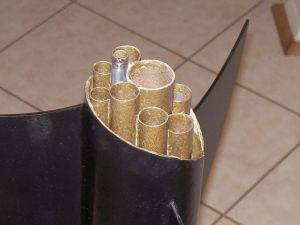Scratch Landshark 2.0 Original Design / Scratch Built
Scratch - Landshark 2.0 {Scratch}
Contributed by Dick Stafford
| Manufacturer: | Scratch |

Brief:
My original Landshark flew on 38mm Js and sported some cool shark fin-shaped fins from Giant Leap. Since there was
little hope it would ever fly again, I decided to reuse the fins on a much smaller and lighter model. The new version
is 3" in diameter and flies on 29mm power.
Construction:
The parts list:
- 3/32" G10 shark fins (OOP)
- 3" mailing tube
- 3" LOC nose cone
- 3/32" Kevlar®
- 29mm motor tube
- 2 plywood CRs
- 3" aluminum standoff with hardware
- FirstFire igniter tube
- 18mm tubing
- 13mm tubing
- Plastic airplane kit
- Buttons from railbuttons.com
I won't go into all the gory details but will describe the construction in general.
First, the overall design. As I was starting this project, I was reintroduced to PemTech's Bucky Jones Space Cadet. Long story short, I stole the idea for the offset fins, the curved tail, and the extra tail tubes. The fins are of course different and I used a different compliment of tubes.
 Recovering the fins took a ton of grinding a prying. That was a chore. Let me tell you,
Kevlar®
lamination will eat a cutting wheel faster than steel! The fins had tabs for a 4" BT and a 3" MMT. I had
considered trimming them to create the proper tab depth, but decided to just using a long motor tube adjusting the
length of the fin slots accordingly. The latter required a ruler and a calculator to determine where the fins would
emerge from the body. I attached the front ring and dry fit the rear one. I then slid the long front end of the fins up
into the slot and shoved the back end in. Since the fins were curved where they entered the body, the ends of the tabs
needed a tad of extra filler. No problemo.
Recovering the fins took a ton of grinding a prying. That was a chore. Let me tell you,
Kevlar®
lamination will eat a cutting wheel faster than steel! The fins had tabs for a 4" BT and a 3" MMT. I had
considered trimming them to create the proper tab depth, but decided to just using a long motor tube adjusting the
length of the fin slots accordingly. The latter required a ruler and a calculator to determine where the fins would
emerge from the body. I attached the front ring and dry fit the rear one. I then slid the long front end of the fins up
into the slot and shoved the back end in. Since the fins were curved where they entered the body, the ends of the tabs
needed a tad of extra filler. No problemo.
Before I permanently attached the aft ring, I added internal fillets and attached a 3" long aluminum standoff. This has threaded holes on each end. One end is screwed onto the ring and the other will be used to attach a small washer for motor retention. This standoff is roughly the same diameter as a First Fire tube. It sits nestled against the motor tube and the tab from the top fin.
 I added a piece of a First Fire tube on the opposite side for symmetry. Working down from
top to bottom, I then added one 13mm tube and three 18mm tubes on each side and one 13mm tube on the bottom. As with
the Bucky Jones, each of these tubes is shorter than the one above.
I added a piece of a First Fire tube on the opposite side for symmetry. Working down from
top to bottom, I then added one 13mm tube and three 18mm tubes on each side and one 13mm tube on the bottom. As with
the Bucky Jones, each of these tubes is shorter than the one above.
The shock tether is attached through the body just ahead of the forward ring. I added a piece of coupler so the tube is double walled in this point. I pondered what cockpit I'd use to cover the attachment point and ended up buying a plastic kit with a 50% off Michael's coupon. I'll leave this as a mystery--I bet you can guess which one. I trimmed and sanded to top body half until it was relatively flush. It was then epoxied on and the gaps were filled with SuperFil light epoxy filler.
The last thing to do was add the rail buttons.
Finishing:
I started by painting the tail area. I masked the body and fins and painted this area with Rustoleum Hammered Gold. I
then masked the tail and the windows on the cockpit and painted the rest with Rustoleum Hammered Black. I had painted
the plastic model before attaching it and before attaching the clear windows. I don't know why but I like the hammered
paints. Maybe it's because they hide my poor finishing?
Flight and Recovery:
I loaded a G76 Mojave Green for the first flight. I drilled the delay from 10 to 6 seconds. The boost was great and
it ejected on cue. I didn't have much of a walk but I was shocked how a bean field can hide a rocket of this size.
Luckily, I had help finding it.
Summary:
I think this rocket looks pretty cool, but it would be hard to make it look bad with those cool fins. Too bad Giant
Leap discontinued them.
People at the launch said it looks more like a Batman theme vs a shark. I agreed but decided to stick with the legacy Landshark name.
Sponsored Ads
 |
 |











